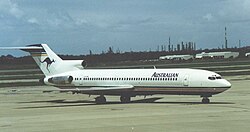Trans Australia Airlines
| Trans Australia Airlines | |
|---|---|

|
|
| IATA code : | TN |
| ICAO code : | TAA |
| Call sign : | TRANSAIR |
| Founding: | 1946 |
| Operation stopped: | 1996 |
| Seat: |
Melbourne , Australia |
| Home airport : | Melbourne Airport |
| Fleet size: | |
| Aims: | National and international |
| ceased operations in 1996. The information in italics refer to the last status before the end of operation. | |
Trans Australia Airlines ( TAA ) was a major Australian airline between 1946 and 1992, based in Melbourne and based at Melbourne Airport . The company traded as Australian Airlines from 1986 .
history
Duopoly TAA and ANA
Air Minister Arthur Drake Ford called 1946 the Australian National Airlines Commission and planned together with Daniel McVey, director general of the air traffic authority, the two-airline policy ( Two Airlines Policy ). In accordance with this policy, Trans Australia Airlines was established as a private airline in 1946 with the Australian Government as the sole shareholder. In the same year the TAA started flight operations and was obliged to repay a dividend to the state every year.
Trans Australia Airlines was thus closely associated with the privately owned Australian National Airways (ANA) in the early 1950s . The two airlines dominated the Australian domestic market, where both carried the majority of their passengers. Until the 1970s, TAA was considered the more customer-friendly of the two domestic airlines in Australia and also advertised with the slogan Fly the Friendly Way . The ANA operated by private provider Ivan Holyman, weakened by company takeovers, had to be supported by the state in order to remain competitive with the TAA - in addition, the TAA had to postpone planned innovations for a long time because the ANA could not finance them. Third providers were disadvantaged by the authorities and had to switch to regional air traffic or freight traffic.
Duopoly TAA and Ansett
When Ivan Holyman died in 1957, the ANA board of directors was willing to sell the company to TAA. The government rejected the proposal, and the previously defeated competitor Reginald Ansett (Ansett Airways) bought the ANA below market value. Even during the time of Ansett-ANA (Ansett was heavily burdened by the takeover), TAA's private cartel partner remained structurally weaker. Instead of the more modern jet jets already planned, the TAA had to continue to use turboprop aircraft with the Lockheed Electra Mk2 in order not to have any advantage over the ANA. This situation improved only slowly. This unique regulatory policy in the aviation market has been recognized worldwide for its stability.
In the late 1970s, air traffic regulation was gradually loosened in what came to be known as the Open Skies Policy. TAA invested in the Airbus A300 while Ansett Australia chose the Boeing 767 . In 1986 TAA was renamed Australian Airlines . It was not until the beginning of the 1990s that the first competitive competitors entered the Australian market and the duopoly dissolved. In 1992, Australian Airlines was acquired by the also Australian, state-controlled Qantas and incorporated into the new parent company. Qantas was then privatized in 1995 .
Later use of the name
The name Australian Airlines was used again between 2001 and 2006 by Qantas for the name of a low-cost airline .
Timeline
Incidents
- On August 8, 1951, a Douglas DC-3 / C-47A-20-DK of Trans Australia Airlines ( aircraft registration VH-TAT) crashed into Barilla Bay immediately after taking off from Hobart Airport ( Tasmania ). The machine was on a cargo flight to Melbourne . Both crew members (the only occupants) were killed.
